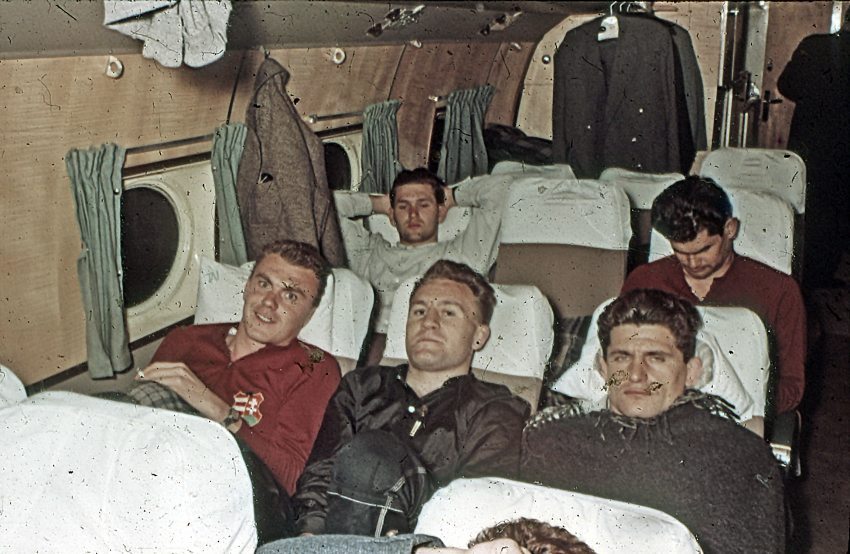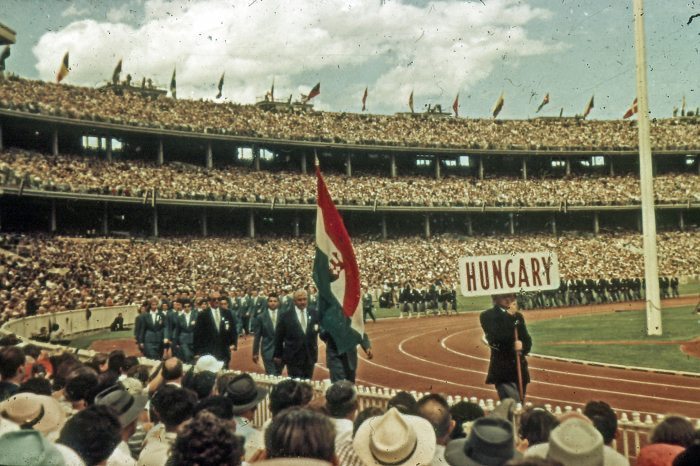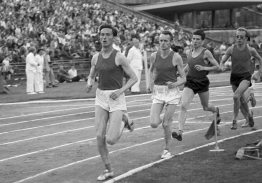The "Melbourne bloodbath", the revenge of the Hungarian water polo team – How we repaid the crushing of the '56 revolution
It would surely be difficult to find a connection between the sight of blood mixing with the pool water, the Olympic performance of our water polo players, and the suppression of the Hungarian Revolution if these were not real events. How the three threads finally intertwined in the most symbolic match of the modern Olympics in 1956 is commemorated in this story, written by life itself.

From autumn in Pest to summer in Melbourne
The 1956 Summer Olympics were held in Melbourne, Australia. The legendary Hungarian water polo team, which would have had a good chance of winning this time too, arrived that year in a rather shattered condition. They were both mentally and physically exhausted because, by the time the Olympic flame was lit in Melbourne on 11 November, the flame of the Hungarian Revolution had already been extinguished in blood by Russian tanks.
The national team was due to depart on 24 October, but the French airline carrying the Olympic team did not take the risk of landing at Ferihegy, Hungary, in those turbulent times. In the end, they agreed to go as far as Prague, Czechoslovakia, and, after some delays, to get the Hungarian team to Australia. In order for the water polo team to catch the bus to Czechoslovakia, team captain Dezső Gyarmati had to be dragged back from the barricades, and young Ervin Zádor, who wanted to say goodbye to his mother, had to walk 25 kilometers across the war-torn countryside to reach the camp.
Finally, the bus did roll out, with the players on the seats deep in thought.
The Hungarian national team had not been able to have training in a pool for three weeks by then and were waiting in a closed training camp to see what the politicians would decide about their fate. They didn't know whether they would even make it to the Olympics, just as they didn't know what would happen to their loved ones at home, and if they got out of the country to the West, whether they would be able to come back. Everything was uncertain, except that if they could play, they would do whatever it took to win for the national flag! The Hungarian team arrived almost at the eleventh hour from a dreary November to a glorious Melbourne summer. There was no time for the planned acclimatization either, with the stake matches starting soon. In the final of three, Yugoslavia was joined by the Soviet Union, and news of the match attracted an incredible crowd to the pool.
Water meant freedom
What did water polo mean and what does it still mean for Hungarians? The Hungarian public and the Hungarian soul have always looked upon the polo players as heroes, and they have repaid this unreserved love with wonderful results. This small country, which has neither ocean nor sea, produces water sports champions every year, and in water polo Hungary, despite its small size, is a world power, even a legend. Water polo is not just a matter of stamina and endurance, but also of strategy and cunning. Water polo players can swim several kilometers in a match without being able to rest on the floating medium; the ball is whizzing along like a car on a highway, passes are quick and accurate; and underwater, there is a constant battle for position. In water polo, as in hockey, only flags are issued for flagrant infringements, and the water covers up a lot... That's why it hasn't become a sport for the reserved Englishmen, for example, but it's in the blood of Hungarians.
When a muscular player rises out of the water up to his waist and throws, we can easily imagine that he’d even be able to walk on that water if he wanted to.
The sophisticated and aggressive game is close to the Hungarian mindset, and over the years it has become a symbol of Hungarian uniqueness. "In Hungary, every water has a different taste," said our Olympic champion Miklós Martin, nicknamed Buci ("Bun") by his teammates because of his bun-round face.
During the socialist era, sport played a prominent role in Hungarian public life and communities, as it remained almost the only legal form of self-expression. Professional sportsmen and women were much freer than the average person, they could travel beyond the Iron Curtain and only had to work on paper. However, these privileges went hand in hand with the political leadership's use of athletes for its own propaganda purposes, using their achievements to justify the success and legitimacy of the socialist system. This special status offered even players from disadvantaged, aristocratic backgrounds hopes of avoiding marginalization. Water polo opened doors and created a world of its own, which was, and maybe still is, passed down from father to son. Water meant freedom.
The pool was simmering beneath the surface
During the communist era, the excellence of the water polo players was envied even by the leader of the Soviet party state, Stalin, who sent the Soviet water polo team to Hungary to learn.
The Hungarian training program included skiing, on which swimming and ball-handling techniques were later built. The Russian coaches were diligently taking notes in our stands, learning how the Hungarians solved all the elements from movement, how they shot using a turn, and then copied the training plans and took all the knowledge home. At the Helsinki Olympics, there was even a possibility that the Hungarian team might concede the match to the Soviet team. It was not their idea... By 1956, the Russian team was a serious threat to the Hungarian boys, and they were beginning to outgrow their masters.
"Whatever you decide, let's win the Olympics first," captain Dezső Gyarmati told the troubled team, many of whom were considering not returning to Hungary after the Games. And the match began. In the Melbourne stands on that legendary afternoon - 6 December 1956, a month after the Hungarian Revolution was crushed in blood - eight thousand people packed into six thousand seats, many of them paying £30-£40 for a two-pound ticket. The spectators were aware of what was happening in Hungary and stood with the oppressed state, whose citizens were trying to win their freedom against a powerful aggressor.
The Russian national team already received a huge backlash when they came out of the dressing room with CCCP-emblazoned on their jerseys. The same inscription was also on the Soviet tanks that the Australian audience saw on the news... The humid atmosphere was extremely tense, which the Swedish referee was well aware of. In the first quarter, the Hungarians scored from a penalty that the referee had retaken after the failed shot, and at the moment of its launch, the Soviet goalkeeper was not even fully prepared for the shot. The Soviet players' tempers were running high, with the pool simmering with tension beneath the surface.
"I felt like I had five liters of soda fizzing in my head," said Ervin Zádor, the youngest player on the team.
A bloody outcome
The Hungarian team used a new strategy in the game, which they had come up with the night before in the hotel: a zone defense, which had never been used in the pool at the Olympics before. They also defended the forwards with a tight man-to-man defense. This unexpected strategy confused the opponents, who could not shoot at all from close range, and their long-range shots were defended by Otto Boros. This really unnerved the opposing players. Georgij Msvenieradze, the two-handed shooter, started swearing and fighting incredibly in the water, and the Hungarian players replied to it neither silently nor idly. We were leading 4-0 with only a few minutes left in the game when the players switched to a violent style.
Ervin Zádor admitted later that he had not used his most sophisticated vocabulary, and although Valentyin Prokopov, the giant Soviet player, probably did not speak Hungarian, he broke the skin under Zádor's eyes with a full-force underwater elbow strike. He rose out of the water towering like an angry Loch Ness monster. It was a big blow, bleeding profusely, and it quickly stained the pool pink. The crowd roared, and at that moment the Hungarian player became an epic symbol of the Hungarian fight for freedom.
With good strategic sense, he did not get out of the water on the dressing room side, but walked along the front of the grandstand, blood pouring from his eyes and running down his wet chest, almost covered in blood on his upper body.
The photograph taken of him at that moment spread around the world and became a symbol of the crushing of a small state.
As emotions ran out of control, the referee called the game off one minute before time, and the Hungarians won. The crowd jumped over the barrier, the Soviet players walked out amidst a line of police, and the usual handshakes didn't happen. Spectators chanted "Hungary, Budapest!". And the ball was floating gently on the water.
A lesser-known detail of the story is that the match against the Soviet Union was not the Olympic final: it came afterward against the very talented Yugoslavian national team, and Ervin Zádor was not allowed to play in this match, despite his pleas to his coach. Propokov's huge blow could not change that match, but it still threatened our Olympic gold medal. But the Hungarian team won that match too. We showed the world that in conditions where seven men fight seven men, where the rules are the same for everyone, where there is no dictatorship, no informer network, and no iron curtain, we are capable of winning. Without tanks – with a ball.
The members of the Hungarian water polo team at the 1956 Olympics were: Antal Bolvári, Ottó Boros, Dezső Gyarmati, István Hevesi, László Jeney, Tivadar Kanizsa, György Kárpáti, Kálmán Markovits, Mihály Mayer, István Szívós and Ervin Zádor.








